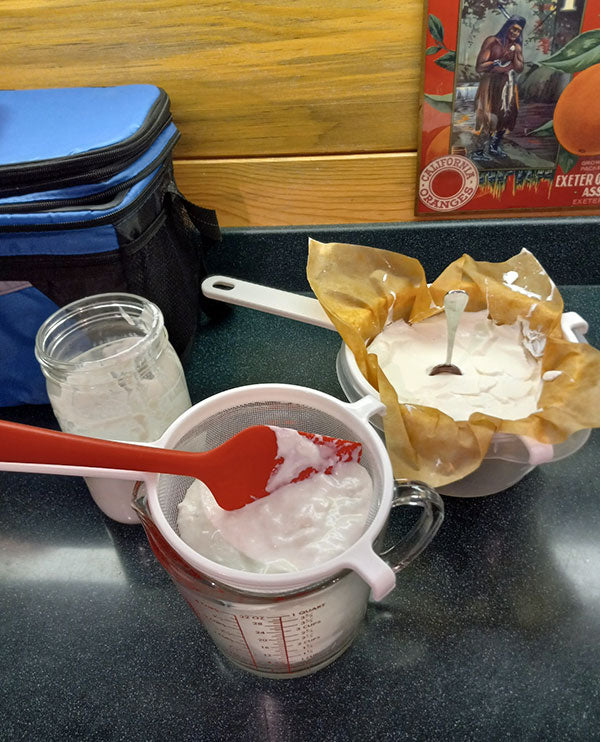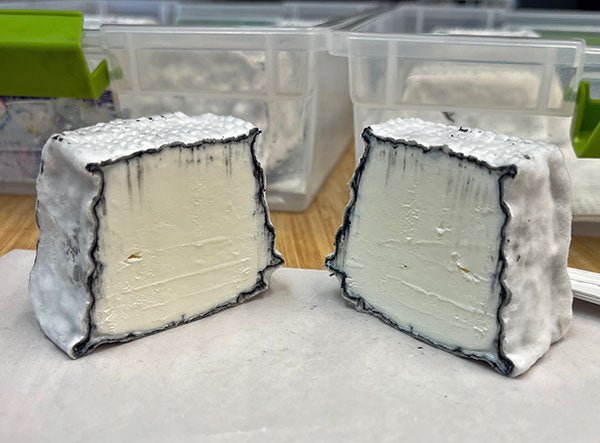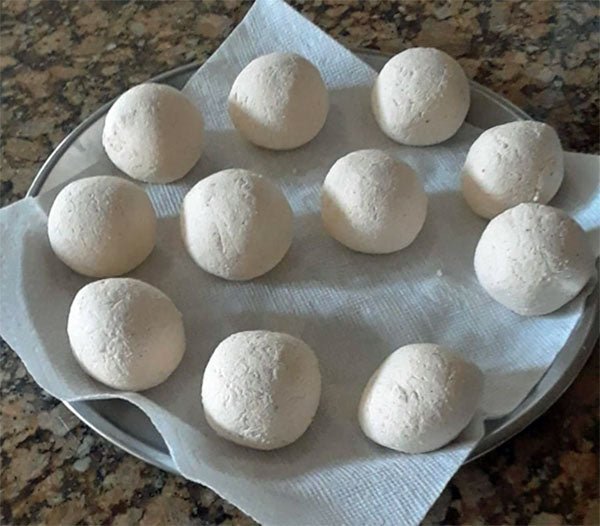Aline and her husband, Ned Tompkins have a small farm outside the tiny town of Applegate, Oregon (population 1,116).
Along with their goats (7 does, a buck and a wether) they have a McNab pup and 6 chickens.
Ned is an organic gardener and they have always had gardens wherever they lived.
They’ve only been at their new farm for a year and Aline told us the name, Lazy 8 Acres, is a bit tongue in cheek. If it were turned into a cattle brand, it would be the number 8 lying on it’s side, which is the mathematical symbol for infinity. (Apparently, even a small farm can generate an infinite amount of chores!)

Etsy card
Aline’s Story
Dairy goats have been in my life on and off since the 1970’s, mostly Alpines, Nubians, and LaManchas. Goats were around while I worked on cattle ranches to put myself through college, and in the early years of my career as an archaeologist.
I shifted to Nigerian Dwarf dairy goats in the early 2000’s when my husband and I moved to a farm in Colorado where I finally retired from archaeology and started a second career as a licensed massage therapist.
I was introduced to the culture and natural wonders of Hawai’i at a week long massage training on the island of Maui. Our teacher told the class a story about an owl that was native to Hawai’i.
This inspired me to write and publish a novel, Hooked by the Stars: Pueo’s Voyage to Hawai’i, a historical fantasy where magic influences the crew of a Polynesian voyage in the time of the ancestors.

The book is available at bookstores or online at Amazon, Barnes and Noble, etc. A dollar for every book sold goes to the University of Hawai’i Pueo Project.
As an aside, did you know they have surfing goats on Maui? And goats join their owners on SUPs (Stand Up Paddle boards) skimming across ponds in Michigan?
Anyway, I have done a lot of different things over the decades, and goats were usually not far away.
Nigerian Dwarfs are an American breed of miniature goat of West African origin, bred to have the structure, in proportion, of their larger dairy goat cousins.
I love them because they are affectionate, their size makes fencing and shelter much easier, and their milk is the highest in butterfat of all the dairy breeds.
Nigerians average 6% with some remarkable individuals from elite herds producing up to 10%. I may get less milk from these minis, but the yield when I make cheese is more. Fair trade for living with these delightful characters.
My current herd started when we moved to less than an acre of desert land surrounded by much larger properties. We were surprised that there were more horses than people in the Rio Verde Foothills of Arizona. Sounds carry a long way in the desert.
Early one morning, along with the distinctive calls of wild birds in the Ironwood trees and roosters crowing a couple blocks away, I distinctly heard the bleating call of goats. I asked my new neighbor, Carol Schuler, if I had imagined the goats.
It turned out that there were several herds in the area and at one time she had sourced the milk for her cheese from a local Nigerian Dwarf herd. (Note: Carol is truly an extraordinary cheese maker and we interviewed her in 2020 (click here).)
I decided we had lived too long without goats and found an excellent breeder nearby. I bought three ADGA registered does. Koko was two months pregnant, Gussy and Molly were still just
kids. The “herd” was hauled home in the back seat of my Toyota 4-runner.
It doesn’t take a lot of goats, or a lot of land to produce cheese straight from the udder. It does take time.
Until Carol gave me her copy of Ricki Carroll’s Home Cheese Making, all I had ever done with my goat milk was make traditional yogurt and ice cream. With a new vocabulary of all things cheese, I began searching for articles on the internet.
I bought David Asher’s book, The Art of Natural Cheesemaking, and read it cover to cover while waiting for Koko’s kids to hit the ground.
I also bought a good digital thermometer which has turned out to be an essential tool. Most everything else I needed to make cheese was already in my kitchen.
Once Koko’s four bouncing kids were weaned, I began to milk her twice a day and got a little over a quart. This was enough to experiment with fermenting raw milk with kefir grains.*
Kefir is rich in probiotics. I like it thinned with cold pear juice for a refreshing drink.
By experimenting, I found the easiest way to make a thick, creamy, uncooked yogurt was to strain the whey from the kefir by lining a fine mesh plastic sieve with a coffee filter and setting this over a bowl in the fridge for a day or two.
Next, I started making small batch fresh cheeses like queso fresco (aka paneer) and fast ricotta. Then I ventured into the realm of using kefir as the starter culture and rennet to make chèvre.
When we moved to Oregon, Koko was upset by all the commotion. Breeding season came and went without her settling, but Gussy and Molly freshened in the spring of 2021.
Nigerian Dwarf kids are so cute and there is always the risk of goats becoming exponential on your farm.
Since these little ones came from excellent dairy lines, I just had to keep all five kids, right? I decided to shift to once a day milking because there is a lot of work to do on our new property, the Lazy 8 Acres.
From two goats that dam-raised their kids, I get three pints a day. It doesn’t sound like much, but there are only the two of us using milk for morning coffee. That adds up to 2.5 gallons a week, plenty for my recipes.
A quart of raw milk makes a quart of kefir which yields a pint of yogurt, and because it is never heated, all of the probiotic goodness is there.
I freeze both quarts of milk and quarts of kefir for those times in the early spring when the does are dried off for the last couple months of their pregnancy.
When I want to save milk for making cheese, I put the kefir grains to sleep in a few ounces of milk. They will rest in the refrigerator until I wake them up and put them back to work.
I have put up several quarts of a creamy vanilla custard ice cream, a golden yellow concoction rich with farm fresh eggs and cream I skimmed from the goat milk.
I make a kind of ricotta textured cheese.

A fresh ricotta textured cheese. There’s a video of the recipe on my Lazy8Acres Facebook page.
It’s the same process as queso fresco, cooked at a slightly lower temperature, cultured with kefir and the curd set with vinegar. It is soft and crumbly. Another fresh cheese with a ricotta texture can be made with 2 quarts of milk and 2 cups of whey from the kefir yogurt process.
My chèvre is from Asher’s book and uses kefir for the starter culture. It develops a lovely bloom and smells like cheesecake, even before adding powdered sugar if that’s its final destination.

My no-bake cheesecake is a variation on a Vermont Creamery recipe (click here). I replace the cream cheese with chèvre, so the filling is just 12 ounces of chèvre, a cup of cream and 1/2 cup powdered sugar. Simple and delicious.
I use Walcoren rennet, the tiny grain size tablets are the easiest to use for small batch cheese. A gallon of milk produces two pounds of chèvre.
Finally, I’ll make a ricotta from the whey, gleaning the last bits of protein. Sometimes this fails to set, but my chickens love whey fermented grain so I don’t mind too much when I fail.
What am I doing next? I need a cave, or at least a space with a controlled environment to encourage the desirable bacterial cultures during the curing and aging. That will open up a whole new world of cheese recipes.
Neighbors have asked if I have enough milk to sell. Not right now is the answer, but I certainly will if all the does freshen next year. Oregon allows the sale of raw goat milk from the farm premises as long as you have 9 or less does in milk.
On the dairy side, I have not done milk testing for my girls, something I may do in the future to measure the quality of the milk and the results of my breeding program.
We have the potential to have 7 girls milking next year, but I don’t know if I’m up to that chore. After all, we are the Lazy 8 Acres.
Lazy 8 Nigerian Dwarf Dairy Goats
Facebook farm page: https://www.facebook.com/lazy8acres
Aline LaForge
Facebook book page: https://www.facebook.com/HookedByTheStars
*I ferment my kefir in quart jars in a small insulated bag. In the winter, I heat a corn bag in the microwave to get the culture growing. The kefir is gently pressed through a fine plastic sieve and the grains are stirred into the next jar of raw milk. I use a high quality square coffee filter (Chemex) to strain the whey, resulting in an uncooked yogurt that is so thick it will hold a spoon. An inexpensive unbleached basket type coffee filter works, but it won’t hold a quart of kefir.


































































































































































